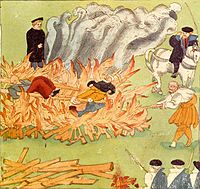
The Abbey of Saint Gall is a dissolved abbey (747–1805) in a Catholic religious complex in the city of St. Gallen in Switzerland. The Carolingian-era monastery existed from 719, founded by Saint Othmar on the spot where Saint Gall had erected his hermitage. It became an independent principality between 9th and 13th centuries, and was for many centuries one of the chief Benedictine abbeys in Europe. The library of the Abbey is one of the oldest monastic libraries in the world.

Johann Jakob Scheuchzer was a Swiss physician and natural scientist born in Zürich. His most famous work was the Physica sacra in four volumes, which was a commentary on the Bible and included his view of the world, demonstrating a convergence of science and religion. It was richly illustrated with copperplate etchings and came to be called the Kupfer-Bibel or "Copper Bible".

Heinrich Bullinger was a Swiss Reformer and theologian, the successor of Huldrych Zwingli as head of the Church of Zürich and a pastor at the Grossmünster. One of the most important leaders of the Swiss Reformation, Bullinger co-authored the Helvetic Confessions and collaborated with John Calvin to work out a Reformed doctrine of the Lord's Supper.

Johann Jakob Grynaeus or Gryner was a Swiss Protestant divine.

Several illustrated chronicles were created in the Old Swiss Confederacy in the 15th and 16th centuries. They were luxurious illuminated manuscripts produced for the urban elite of Bern and Lucerne, and their copious detailed illustrations allow a unique insight into the politics and daily life of late medieval Switzerland on the eve of the Reformation. The most important of these chronicles are the works of the two Diebold Schillings, their luxurious execution, as well as their content reflecting the growing confidence and self-esteem of the leaders of the confederacy after their spectacular successes in the Burgundian Wars.
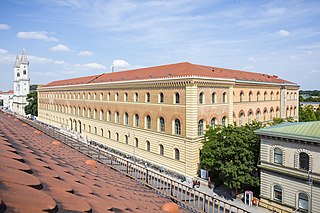
The Bavarian State Library in Munich is the central "Landesbibliothek", i. e. the state library of the Free State of Bavaria, the biggest universal and research library in Germany and one of Europe's most important universal libraries. With its collections currently comprising around 10.89 million books, it ranks among the leading research libraries worldwide. The Bayerische Staatsbibliothek furthermore is Europe's second-largest journals library. Furthermore, its historical holdings encompass one of the most important manuscript collections of the world, the largest collection of incunabula worldwide, as well as numerous further important special collections. Its collection of historical prints before 1850 totals almost one million units.

Johann Jakob Hottinger was a Swiss theologian.

The Saxon State and University Library Dresden, abbreviated SLUB Dresden, is located in Dresden, Germany. It is both the regional library for the German State of Saxony as well as the academic library for the Dresden University of Technology. It was created in 1996 through the merger of the Saxon State Library (SLB) and the University Library Dresden (UB). The seemingly redundant name is to show that the library brings both these institutional traditions together.
The Swiss Brethren are a branch of Anabaptism that started in Zürich, spread to nearby cities and towns, and then was exported to neighboring countries. Today's Swiss Mennonite Conference can be traced to the Swiss Brethren.
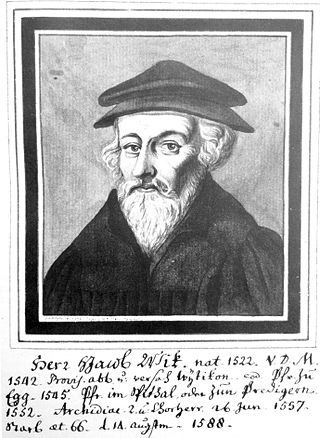
Johann Jakob Wick was a Protestant clergyman from Zürich.
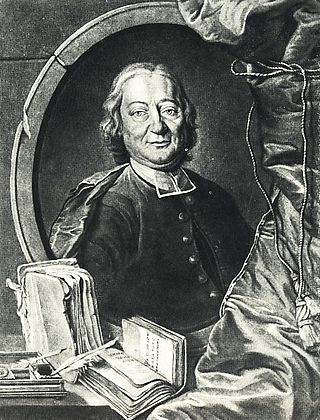
Johann Jakob Breitinger was a Swiss philologist and author.

Zentralbibliothek Zürich is a library in Zürich, Switzerland. It is the main library of both the city and the University of Zurich, housed in the Predigerkloster, the former Black Friars' abbey, in the old town's Rathaus quarter.
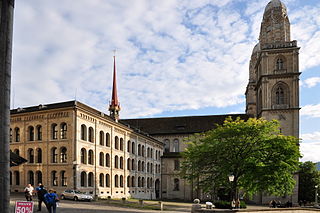
The Carolinum is the predecessor educational institution of the theological faculty of the University of Zürich, established in 1525. As building, it is part of the former cloister of the Grossmünster Chorherrenstift in Zurich, Switzerland. Grossmünster and Carolinum are listed in the Swiss inventory of cultural property of national and regional significance as a Class A object.

Staatsarchiv Zürich, formally the Staatsarchiv des Kantons Zürich, are the state archives of the Swiss Canton of Zürich and its legal predecessors, in particular the former city republic of Zürich.

Predigerkirche is one of the four main churches of the old town of Zürich, Switzerland, besides Fraumünster, Grossmünster and St. Peter. First built in 1231 AD as a Romanesque church of the then Dominican Predigerkloster, the Basilica was converted in the first half of the 14th century, the choir between 1308 and 1350 rebuilt, and a for that time unusual high bell tower was built, regarded as the highest Gothic edifice in Zürich.

The Predigerkloster was a monastery of the Dominican Order, established around 1234 and abolished in 1524, in the imperial city of Zürich, Switzerland. Its church, the Predigerkirche, is one of the four main churches in Zürich and was first built in 1231 as a Romanesque church of the then Dominican monastery. In the first half of the 14th century it was converted, the choir between 1308 and 1350 rebuilt, and a for that time unusually high bell tower built, regarded as the highest Gothic edifice in Zürich.

The Reformation in Zürich was promoted initially by Huldrych Zwingli, who gained the support of the magistrates of the city of Zürich and the princess abbess Katharina von Zimmern of the Fraumünster Abbey, and the population of the city of Zürich and agriculture-oriented population of the present Canton of Zürich in the early 1520s. It led to significant changes in civil life and state matters in Zürich and spread to several other cantons of the Old Swiss Confederacy, and thus initiated the Reformation in Switzerland.

Johann Caspar Scheuchzer, was a Swiss naturalist, physician and writer on the history and culture of Japan

Gerold Meyer von Knonau was a Swiss geographer and historian whose most enduring contribution to scholarship may well have been his pioneering work between 1837 and 1858 as cantonal archivist for Zürich and the surrounding region.

Johann Jakob Breitinger was a Reformed pastor in Zürich, professor, antistes and politician.
